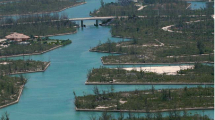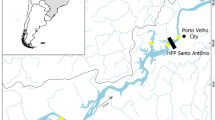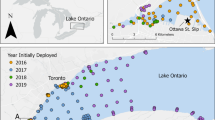Abstract
Effective conservation must account for fish migrations to minimize threats to freshwater fishes. Many floodplain fishes, like giant Neotropical arapaima (genus Arapaima), migrate laterally into seasonally flooded habitats to feed and reproduce. Effects of seasonal migrations on conservation efforts like community-based management remain uncertain. Acoustic telemetry was applied to arapaima in floodplain habitats (Lower Amazon) to characterize (1) lake fidelity, (2) lake population connectivity, and (3) migrations beyond managed units. During low water of 2014, 24 arapaima were captured and implanted with acoustic tags in three lakes within a 10-km diameter and across two fishing communities. During floods, the entire study area was connected, including tagging lakes. Monitoring was continuous over two annual flood cycles using an array of 19 fixed acoustic receivers in four lakes. Additional nearby lakes were surveyed with portable receivers for unaccounted individuals during subsequent dry seasons. On average, 74% of unharvested arapaima returned to the same lake; no arapaima were found outside their lake of tagging origin during subsequent dry seasons. During high water, arapaima migrations were not contained within community management units; three arapaima were found outside their community zone. Overlapping distributions of arapaima from each of three lake populations showed connectivity during flooding, especially near known spawning grounds. Results demonstrate that management by local fishers to regulate fishing within lakes can work because arapaima show fidelity to their lake of tagging origin. Current management efforts could be improved by delineating management units to networks of habitats that sustain arapaima over complete life histories.

adapted from Castello et al. 2015; produced in ArcGIS v.10.3). Acoustic telemetry was used to monitor the movement of arapaima within the highlighted study area (see enlarged in Fig. 2). b Annual water level cycle with 95% confidence intervals for high and low levels based on two decades of monitoring at a station 100 km upstream of Santarém (data from: www.snirh.gov.br/hidroweb/, 1990–2010, Curuai station, -2.2725 S, -55.4808 W)




Similar content being viewed by others
Data availability
Data uploaded to Google Drive: https://drive.google.com/drive/folders/1BfomTfw-QpyBdCVYUA5Jj8Jznhm4mT0x?usp=sharing
Code availability
Not applicable.
References
Arantes CC, Castello L, Cetra M, Schilling A (2013) Environmental influences on the distribution of arapaima in Amazon floodplains. Environ Biol Fish 96:1257–1267. https://doi.org/10.1007/s10641-011-9917-9
Arantes CC, Castello L, Stewart DJ, Cetra M, Queiroz HD (2010) Population density, growth and reproduction of arapaima in an Amazonian river-floodplain. Ecol Freshw Fish 19(3):455–465. https://doi.org/10.1111/j.1600-0633.2010.00431.x
Araripe J, do Rêgo PS, Queiroz H, Sampaio I, Schneider H (2013) Dispersal capacity and genetic structure of Arapaima gigas on different geographic scales using microsatellite markers. PLoS ONE 8(1):e54470. https://doi.org/10.1371/journal.pone.0054470
Arthington AH, Dulvy NK, Gladstone W, Winfield IJ (2016) Fish conservation in freshwater and marine realms: status, threats and management. Aquat Conserv 26(5):838–857. https://doi.org/10.1002/aqc.2712
Campos-Silva JV, Hawes JE, Peres CA (2019) Population recovery, seasonal site fidelity, and daily activity of pirarucu (Arapaima spp.) in an Amazonian floodplain mosaic. Freshw Biol 64(7):1255–1264. https://doi.org/10.1111/fwb.13301
Campos-Silva JV, Peres CA (2016) Community-based management induces rapid recovery of a high-value tropical freshwater fishery. Sci Rep 6:34745. https://doi.org/10.1038/srep34745
Castello L (2008a) Nesting habitat of Arapaima gigas (Schinz) in Amazonian floodplains. J Fish Biol 72(6):1520–1528. https://doi.org/10.1111/j.1095-8649.2007.01778.x
Castello L (2008b) Lateral migration of Arapaima gigas in floodplains of the Amazon. Ecol Freshw Fish 17(1):38–46. https://doi.org/10.1111/j.1600-0633.2007.00255.x
Castello L, Arantes CC, Mcgrath DG, Stewart DJ, Sousa FS (2015) Understanding fishing-induced extinctions in the Amazon. Aquat Conserv 25(5):587–598. https://doi.org/10.1002/aqc.2491
Castello L, McGrath DG, Hess LL, Coe MT, Lefebvre PA, Petry P et al (2013) The vulnerability of Amazon freshwater ecosystems. Conserv Lett 6(4):217–229. https://doi.org/10.1111/conl.12008
Castello L, Stewart DJ (2010) Assessing CITES non-detriment findings procedures for Arapaima in Brazil. J Appl Ichthyol 26(1):49–56. https://doi.org/10.1111/j.1439-0426.2009.01355.x
Castello L, Viana JP, Watkins G, Pinedo-Vasquez M, Luzadis VA (2009) Lessons from integrating fishers of arapaima in small-scale fisheries management at the Mamirauá Reserve, Amazon. Environ Manag 43(2):197–209. https://doi.org/10.1007/s00267-008-9220-5
Castro F, McGrath DG (2003) Moving toward sustainability in the local management of floodplain lake fisheries in the Brazilian Amazon. Hum Organ 62(2):123–133. https://doi.org/10.17730/humo.62.2.9bkh58xeekj6bg0m
Cavole LM, Arantes CC, Castello L (2015) How illegal are tropical small-scale fisheries? An estimate for arapaima in the Amazon. Fish Res 168:1–5. https://doi.org/10.1016/j.fishres.2015.03.012
Crook DA, Buckle DJ, Morrongiello JR, Allsop QA, Baldwin W, Saunders TM, Douglas MM (2019) Tracking the resource pulse: movement responses of fish to dynamic floodplain habitat in a tropical river. J Anim Ecol 89(3):795–807. https://doi.org/10.1111/1365-2656.13146
Crossa M, Rocha W, Pinto Sá E (2003) Una participative experiência: promisora para el subsidio de programas de manejo del pirarucú (Arapaima gigas Cuvier) en el bajo Amazonas. In: Alcántara Bocanegra F, Montreuil Frías V (eds) Seminario taller internacional de manejo de paiche o pirarucú. Instituto de Investigaciones de la Amazonia Peruana (IIAP), Iquitos, Perú; World Wildlife Foundation (WWF) - Russell E. Train Education for Nature Program, pp 67–81
dos Santos CH, de Sá Leitão CS, de Nazaré P-S (2014) Genetic relationships between captive and wild subpopulations of Arapaima gigas (Schinz, in Cuvier, 1822). Int J Fish Aquac 6(10):108–123. https://doi.org/10.5897/IJFA14.0415
Dudgeon D, Arthington AH, Gessner MO, Kawabata ZI, Knowler DJ, Lévêque C et al (2006) Freshwater biodiversity: importance, threats, status and conservation challenges. Biol Rev 81(2):163–182. https://doi.org/10.1017/S1464793105006950
Farias IP, Willis S, Leao A, Verba JT, Crossa M, Foresti F et al (2019) The largest fish in the world’s biggest river: genetic connectivity and conservation of Arapaima gigas in the Amazon and Araguaia-Tocantins drainages. PLoS ONE 14(8):e0220882. https://doi.org/10.1371/journal.pone.0220882
Gorman OT, Stone DM (1999) Ecology of spawning humpback chub, Gila cypha, in the Little Colorado River near Grand Canyon, Arizona. Environ Biol Fish 55(1–2):115–133. https://doi.org/10.1023/A:1007450826743
Gurdak DJ, Arantes CC, Castello L, Stewart DJ, Watson LC (2019) Evidence of recoveries from tropical floodplain fisheries: three examples of management gains for South American giant Arapaima. In: Krueger CC, Taylor WW, Youn S-J (eds) From catastrophe to recovery: stories of fishery management success. American Fisheries Society, Bethesda, pp 267–295
Gurdak DJ, Stewart DJ, Castello L, Arantes CC (2019) Diversity in reproductive traits of arapaima (Arapaima spp., Müller, 1843) in Amazonian várzea floodplains: conservation implications. Aquat Conserv 29(2):245–257. https://doi.org/10.1002/aqc.3030
Hauser M, Doria CR, Santos RV, García-Vasquez A, Pouilly M, Pécheyran C et al (2019) Shedding light on the migratory patterns of the Amazonian goliath catfish, Brachyplatystoma platynemum, using otolith 87Sr/86Sr analyses. Aquat Conserv 29(3):397–408. https://doi.org/10.1002/aqc.3046
He F, Zarfl C, Bremerich V, Henshaw A, Darwall W, Tockner K, Jaehnig SC (2017) Disappearing giants: a review of threats to freshwater megafauna. Wires Water 4(3):e1208. https://doi.org/10.1002/wat2.1208
Hegg JC, Giarrizzo T, Kennedy BP (2015) Diverse early life-history strategies in migratory Amazonian catfish: implications for conservation and management. PLoS ONE 10(7):e0129697. https://doi.org/10.1371/journal.pone.0129697
Helfman GS (2007) Fish conservation: a guide to understanding and restoring global aquatic biodiversity and fishery resources. Island Press, Washington
Hermann TW, Stewart DJ, Limburg KE, Castello L (2016) Unravelling the life history of Amazonian fishes through otolith microchemistry. R Soc Open Sci 3(6):160206. https://doi.org/10.1098/rsos.160206
Hogan ZS, Moyle PB, May B, Zanden MJ, Baird IG (2004) The imperiled giants of the Mekong: ecologists struggle to understand—and protect—Southeast Asia’s large migratory catfish. Am Sci 92(3):228–237
Junk WJ, Bayley PB, Sparks RE (1989) The flood pulse concept in river-floodplain systems. In: Dodge DP (ed) Proceedings of the international large river symposium. Can Spec Publ Fish Aquat Sci 106, Ottawa, pp 110–127
Junk WJ, Piedade MT, Schöngart J, Cohn-Haft M, Adeney JM, Wittmann F (2011) A classification of major naturally-occurring Amazonian lowland wetlands. Wetlands 31(4):623–640. https://doi.org/10.1007/s13157-011-0190-7
Junk WJ, Wantzen KM (2004) The flood pulse concept: new aspects, approaches and applications- an update. In: Welcomme RL, Petr T (eds) Proceedings of the second international symposium on the management of large rivers for fisheries. Food and Agriculture Organization and Mekong River Commission, FAO Regional Office for Asia and the Pacific, Bangkok, pp 117–149
Klimley AP (1993) Highly directional swimming by scalloped hammerhead sharks, Sphyrna lewini, and subsurface irradiance, temperature, bathymetry, and geomagnetic field. Mar Biol 117(1):1–22. https://doi.org/10.1007/BF00346421
Lennox RJ, Paukert CP, Aarestrup K, Auger-Méthé M, Baumgartner L, Birnie-Gauvin K et al (2019) One hundred pressing questions on the future of global fish migration science, conservation, and policy. Front Ecol Evol 7:286. https://doi.org/10.3389/fevo.2019.00286
Lucas M, Baras E (2008) Migration of freshwater fishes. Blackwell Science, Oxford
McClain ME, Naiman RJ (2008) Andean influences on the biogeochemistry and ecology of the Amazon River. Bioscience 58(4):325–338. https://doi.org/10.1641/B580408
McGrath DG, Castello L, Almeida OT, Estupiñán GM (2015) Market formalization, governance, and the integration of community fisheries in the Brazilian Amazon. Soc Nat Resour 28(5):513–529. https://doi.org/10.1080/08941920.2015.1014607
Melack JM, Forsberg BR (2001) Biogeochemistry of Amazon floodplain lakes and associated wetlands. In: McClain ME, Victoria R, Richey JE (eds) The biogeochemistry of the Amazon basin. Oxford University Press, New York, pp 235–274
Meyer CG, Holland KN, Papastamatiou YP (2005) Sharks can detect changes in the geomagnetic field. J R Soc Interface 2(2):129–130. https://doi.org/10.1098/rsif.2004.0021
Northcote TG (1984) Mechanisms of fish migration in rivers. In: McCleave JD, Arnold GP, Dodson JJ, Neill WH (eds) Mechanisms of migration in fishes. Springer, Boston, pp 317–355
Núñez-Rodríguez J, Duponchelle F, Cotrina-Doria M, Renno JF, Chavez-Veintimilla C, Rebaza C et al (2015) Movement patterns and home range of wild and re-stocked Arapaima gigas (Schinz, 1822) monitored by radio-telemetry in Lake Imiria, Peru. J Appl Ichthyol 31:10–18. https://doi.org/10.1111/jai.12972
Patten DT, Harpman DA, Voita MI, Randle TJ (2001) A managed flood on the Colorado River: background, objectives, design, and implementation. Ecol Appl 11(3):635–643. https://doi.org/10.1890/1051-0761(2001)011[0635:AMFOTC]2.0.CO;2
Petersen TA, Brum SM, Rossoni F, Silveira GF, Castello L (2016) Recovery of Arapaima sp. populations by community-based management in floodplains of the Purus River Amazon. J Fish Biol 89(1):241–248. https://doi.org/10.1111/jfb.12968
Pusey B, Kennard MJ, Arthington AH (eds) (2004) Freshwater fishes of north-eastern Australia. CSIRO Publishing, Nathan
Putman NF, Lohmann KJ, Putman EM, Quinn TP, Klimley AP, Noakes DL (2013) Evidence for geomagnetic imprinting as a homing mechanism in Pacific salmon. Curr Biol 23(4):312–316. https://doi.org/10.1016/j.cub.2012.12.041
Quinn TP (1980) Evidence for celestial and magnetic compass orientation in lake migrating sockeye salmon fry. J Comp Physiol 137(3):243–248. https://doi.org/10.1007/BF00657119
Richard JC, Castello L, Gurdak DJ, Peoples BK, Angermeier PL (2018) Size-structured habitat selection by arapaima in floodplain lakes of the Lower Amazon. Aquat Conserv 28(6):1403–1413. https://doi.org/10.1002/aqc.2969
Scholz AT, Horrall RM, Cooper JC, Hasler AD (1976) Imprinting to chemical cues: the basis for home stream selection in salmon. Sci 192(4245):1247–1249. https://doi.org/10.1126/science.1273590
Schons SZ, Amacher G, Cobourn K, Arantes C (2020) Benefits of community fisheries management to individual households in the floodplains of the Amazon River in Brazil. Ecol Econ 169:106531. https://doi.org/10.1016/j.ecolecon.2019.106531
Strayer DL, Dudgeon D (2010) Freshwater biodiversity conservation: recent progress and future challenges. J N Am Benthol Soc 29(1):344–358. https://doi.org/10.1899/08-171.1
Torres-Vásquez MI, Ruíz JS, Robles EC, Salas FA (2017) Monitoreo de la abundancia de Arapaima gigas en la cuenca baja del Río Pacaya, Reserva Nacional Pacaya Samiria. Amazonía Peruana. Folia Amazónica 26(2):175–186. https://doi.org/10.24841/fa.v26i2.426
Watson LC, Stewart DJ (2020) Growth and mortality of the giant arapaima in Guyana: implications for recovery of an over-exploited population. Fish Res 231:105692. https://doi.org/10.1016/j.fishres.2020.105692
Welcomme RL (1979) Fisheries ecology of floodplain rivers, 2nd edn. Longman Press, London
Winn HE, Salmon M, Roberts N (1964) Sun-compass orientation by parrot fishes. Z Tierpsychol 21(4):798–812. https://doi.org/10.1111/j.1439-0310.1964.tb01219.x
Acknowledgements
We would like to thank Innovasea, formally (and at the time of this fieldwork) known as Vemco, for their generous loan of half the receivers used in this study. This work could not have been accomplished without help from the following institutions: Universidade Federal do Oeste do Pará (UFOPA), Instituto de Pesquisa Ambiental da Amazônia, and SAPOPEMA. We would like to thank David McGrath, Fábio Sarmento de Sousa, Lenise Flôres Vargas da Silva, Luis Reginaldo Ribeiro Rodrigues, and various students from UFOPA for their invaluable contributions during project preparation and execution. We would also like to thank Leandro Castello and Eduardo Martins for sharing their experiences with arapaima telemetry during similar field. We appreciate the comments and feedback of those who reviewed drafts of this manuscript, Leandro Castello, Karin E. Limburg, and Camille Rodriguez Gurdak. Last, but not least, we would like to thank the peoples of the fishing communities in our study area who shared their knowledge of arapaima, granted access to their lakes, and greatly facilitated this work. The individuals and organizations mentioned here have not officially endorsed this publication and the views and opinions expressed here are those of the authors.
Funding
This research was funded in part by: National Geographic Society Committee for Research and Exploration (APK; Grant #9368–13; www.nationalgeographic.org), the US Institute for International Education Fulbright Scholar Program (DJG; us.fulbrightonline.org), the US Environmental Protection Agency under the Science to Achieve Results (STAR) Graduate Fellowship Program (DJG; #F13F11123; https://www.epa.gov/careers/fellowships-scholarships-and-post-doctoral-opportunities), Society of Wetland Scientists Student Research Award (DJG; www.sws.org), Scientific Research Crowdfunding Campaign through “Petridish.org” (DJG), and various funding sources from the SUNY College of Environmental Science and Forestry (DJG) (i.e., Graduate Assistantships in Department of Environmental Biology, the Robert L. Burgess Graduate Scholarship in Ecology, the Wilford Dence Fellowship, the Tropical Social Forestry Fund, and the Maurice and Annette Alexander Wetlands Research Award). The funders had no role in study design, data collection and analysis, decision to publish, or preparation of the manuscript. The organizations mentioned here have not officially endorsed this publication, and the views and opinions expressed here are those of the authors.
Author information
Authors and Affiliations
Contributions
All authors contributed to the study conception and design, including material preparation and data collection and analysis. The first draft of the manuscript was written by Daniel J. Gurdak with supervision from Donald J. Stewart and A. Pete Klimley; all authors commented on previous versions of the manuscript. All authors read and approved the final manuscript.
Corresponding author
Ethics declarations
Ethics approval
This study was conducted under authorization granted by the Brazilian National Ministry of Science, Technology and Innovation (Ministério da Ciência, Tecnologia e Inovação; CNPQ #s: 001141/ 2012–0 and 001609/ 2014–9) and the Brazilian Institute of Environment and Renewable Natural Resources (Instituto Brasileiro do Meio Ambiente e dos Recursos Naturais Renováveis: SISBIO #s: 30201 and 45187). This study was carried out in accordance with the recommendations set forth by the Animal Welfare Act and approved by the Institutional Animal Care and Use Committee (IACUC) at SUNY ESF (protocol #: 121001) and Comissão de Ética no Uso de Animais (CEUA- Ethics Committee on Animal Use) at UFOPA (protocol #: 08010/ 2014).
Competing interests
The authors declare no competing interests
Additional information
Publisher's note
Springer Nature remains neutral with regard to jurisdictional claims in published maps and institutional affiliations.
Appendix 1
Appendix 1
Denoted by a dashed line, neighboring lakes <1-m depth and without fixed receiver stations that were surveyed for tagged arapaima using a portable receiving unit

Rights and permissions
About this article
Cite this article
Gurdak, D.J., Stewart, D.J., Klimley, A.P. et al. Local fisheries conservation and management works: implications of migrations and site fidelity of Arapaima in the Lower Amazon. Environ Biol Fish 105, 2119–2132 (2022). https://doi.org/10.1007/s10641-021-01171-y
Received:
Accepted:
Published:
Issue Date:
DOI: https://doi.org/10.1007/s10641-021-01171-y




